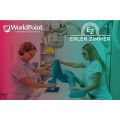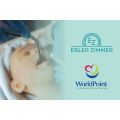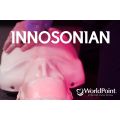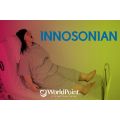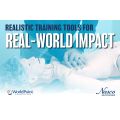HeartTalk with Dr. Benjamin Abella
HeartTalk is WorldPoint’s web video interview series where we ask important questions to leading experts in the CPR and healthcare industry to learn about the important topics that affect people today. Exciting, informative, and educational, HeartTalk will provide you with never-before-heard stories, real life industry experiences, and actionable takeaways. Watch HeartTalk to gain fresh and valuable insights into how we can all work together to improve patient outcomes!
WorldPoint was honored to host Dr. Benjamin Abella of the University of Pennsylvania, to discuss his career in emergency medicine, contributions to the development of CPR feedback, and the future of resuscitation science.
Read the transcript below or watch the video!
Shelly
Dr. Ben Abella, welcome to Heart Talk.
Dr. Abella
Thank you. It's good to be here.
Shelly
We are so excited to spend some time with you today. HeartTalk is WorldPoint's web series, where we have an opportunity to sit down with industry leaders like yourself—innovators—and hear about your work and your passion for the healthcare industry, healthcare training, especially as it relates to resuscitation and improving outcomes from cardiac arrest. So thank you so much for being with us. By way of introduction…there's a lot. So you tell me if I've got this right. You are a professor of emergency medicine and vice chair for research at the University of Pennsylvania. You are an attending physician in the Department of Emergency Medicine, Associate Scholar for the Center for Clinical Epidemiology and Biostatistics, Director for Resuscitation Science, and the medical director for the Penn Acute Research Collaboration, to name a few. Wow!
Dr. Abella
Yes
Shelly
You are this incredible powerhouse! So I'm most interested in maybe we start off with you talking a little bit about your journey. So from genetics and interning and emergency medicine, how did—walk us along. How did you get here?
Dr. Abella
Sure, what's my origin story? So I've always been interested in science my whole life. When I was a kid, I was that guy who read every biology book I could get my hands on. And my dream had always been to be a scientist. And then in college I got a master's in genetics at Cambridge University after university. And my plan had always been to do a Ph.D. and be a laboratory scientist.
But in college, I started becoming more interested in the idea of having impact to people. I always liked people, I always wanted to help the world, and to me, I wanted to be involved in an area of science where I could directly impact humans. And through a series of conversations with friends and mentors, I realized maybe medical school was a good way to go. Then I ended up going to medical school. Always with the idea of being involved in research in some way.
I also, when I went to medical school, fell in love with clinical practice too. It's really fun and impactful and wonderful. And so that led me to starting to think about what field to practice. And emergency medicine appealed because I've always been a high-energy guy. I like stressful situations, I do better under higher stress. I don't do well if things are too relaxed and low stress.
So emergency medicine seemed like a good fit. And then I started to work with a mentor in emergency medicine, Dr. Lance Becker, who has been a lifelong friend and mentor for 20 plus years. And he does, had done, and continues to do CPR and cardiac arrest related work. And so he inspired me that this was a field where there were a lot of questions left to be answered, a lot of work left to be done. It's a very challenging field, but it really spoke to my emergency medicine soul—and that is life or death—it's time sensitive. It really matters. It matters to a lot of people. And if someone can survive cardiac arrest, it's just an amazing and very special thing in many ways for families, for the patients themselves. And so I was hooked.
Shelly
Excellent. Wow, What a journey. And yes, you're wired for the energy and excitement of the emergency room.
So recent news coverage, national news coverage—Damar Hamlin. So there's been this heightened awareness of and interest in CPR, bystander CPR, or resuscitation. Can you share a little bit about your passion for CPR and resuscitation and a little bit about that journey?
Dr. Abella
Yeah. So my passion for CPR, cardiac arrest, that whole topic area started during my residency when I witnessed a lot of cardiac arrest events. And it felt to me like we could do a lot better, like things could be done more effectively. And so I started asking questions and realized that there was a lot to be figured out about how to measure CPR quality, how to think about how medical teams respond to cardiac arrests. And it became a real, real challenge that I wanted to address.
And, you know, the field of cardiac arrest has had a perennial challenge of engagement, both in the community and in hospitals. It's often an afterthought, which is remarkable because hundreds of thousands of cardiac arrests occur every year. It's life or death for all the people who suffer it and their families. It's a—has huge impact.
Yet in hospitals it's just not enough resources. Not enough energy is devoted to it. And in the community as well, people aren't as aware as they should be. You know, when you ask the average American what is CPR, what is an AED, what is cardiac arrest, you would find that the knowledge is highly variable. And that's something that we really need to work on. Anyway.
So I started out doing work on hospital-based cardiac arrest because it felt to me like here we had all the pieces. People are trained in CPR, all the equipment's there. These are professionals who want to do a good job at medicine. So I felt like there was low hanging fruit to improve things, but we had to measure them and they hadn't been measured up until the early 2000s.
And we worked with a number of other groups to develop a monitoring technology for CPR performance that eventually became incorporated into defibrillator products and training simulation products all around the world. And that was exciting because for the first time, people started to think, not only should we do CPR, but we should think about what parts of CPR are important, how should we do it, how can we do it better? And how can we give feedback to teams both during resuscitation and then in the form of debriefing after resuscitation to improve quality?
We helped develop tools and approaches to solve the problem. But one of the biggest humbling lessons for me through all of this was that doing the science is one thing. Bringing it to implementation and having hospitals and practitioners do the thing in real life is, is a whole other challenge.
So the good news for young people listening to this today, there's plenty of work to be done. But every hospital that improves their culture around resuscitation and saves a few more lives a year, those are some very grateful patients and families and someone will have done a real good in the world.
Shelly
So, Dr. Abella, can you share with us some of maybe your most notable work? Some of your most important work or most memorable work?
Dr. Abella
Well, certainly the thing that got me started in this whole business was thinking about CPR quality and probably that's one of the bigger areas that I'm proud of that have had a lot of impact and influence. And we've done and continue to work in that area.
And my students and PhD students and research staff have also focused on epidemiologic questions in cardiac arrest. So, for example, we asked the question of “How many Americans have been trained in CPR,” which interestingly had not been asked. And so we have a number. We did a large, national, random digit dialing survey things and simple stuff. But it was impactful because we discovered that when you asked adult Americans how many people are current in their CPR training or have been trained in CPR, it’s 18%. So one in five. It was done—we did it once and no one’s done it since, maybe it's time for a redo...
Shelly
And when was that?
Dr. Abella
… to see if there’s any progress.
2015, 16, 17, something like that. So, but, you know, a lot of important questions can be asked through epidemiologic research methods. And so another thing we did was we demonstrated that a CPR provision in the world with bystanders is very different if you're a woman victim of cardiac arrest or male victim of cardiac arrest. And that's awful. But an important reality to recognize.
And it highlights that CPR is a complex interaction of bodies, gender. It's in public. There's issues of culture and acceptability. So there's a lot of complex intersections about why that might be the case. But it was clear from our data that women in the U.S., in public, get CPR at a lower rate than men, and that's led to a number of initiatives about trying to make training manikins with women’s morphology so people can be more comfortable with understanding how to do CPR on a woman.
So that that I'm excited about. We've also done epidemiologic work around race and found that socioeconomics and race and neighborhoods matter. And in a way, I'm proud of that because it sort of pays homage to my mentor, Lance Becker, who was one of the very first to show that in Chicago, if you were to ask Lance the question, where did he get started, he would say that one of his first and important works was in the early nineties, where he looked at cardiac arrest in the city of Chicago and found that survival depended on which neighborhood you lived in.
And that started a lot of thinking around CPR training in different communities. And then so we sort of helped show that in a more sophisticated way on a national level that this was a problem. So we've done some work there as well. And then another area that that we spent a lot our team has put a lot of energy into is post-arrest care and thinking about how to improve survival after CPR is successful.
When someone gets CPR and they get their pulse back, there is a big risk of ongoing brain injury. And we've all heard stories of people who had substantial longstanding brain injury and disability after cardiac arrest. And so the journey doesn't stop with successful CPR. And so the question is, what can you do in the hospital to improve brain recovery?
And there's been a lot of work, including from our team, thinking about temperature management, something called targeted temperature management, or TTM, which is the modulation of body temperature to improve healing of the brain. And then also monitoring of the brain using EEG or other brain monitoring techniques. We've done work in that area as well and helped hospitals develop protocols for post-arrest care.
So we developed a program of post-arrest care education where we work with hospitals all around the country to bring them up to speed on how best to address post-arrest injury, which is a complex treatment process in the ICU. So we've done a lot of work there too.
We recognized a number of years ago that implementation of high quality post-arrest care was a big challenge in hospitals. On the one hand, there's all this good science on what to do, but getting people trained in how to do it was the problem. And so we felt this was a place for implementation education. And so we developed this program called the TTM Academy, where we have podcasts, we have online lectures, we have video chat environments, and we do a twice-a-year training course where physicians and nurses come together and they get not just lectures, but we do case-based learning where we walk through cases.
And actually we we've had, I'm proud to say we've had global impact and that we've worked with hospitals in other countries and really help them get started.
Shelly
You mentioned earlier about being creative and a little bit about how your brain works and how you bring that element to the nature of the work that you do. Can you talk a little bit about the creativity that you've brought to resuscitation in terms of how you have researched, looked at the work, looked at the opportunities to do things differently, to make things better with others that you've worked or worked with, and how that's contributed to your work?
Dr. Abella
One of my favorite parts of my job is being creative. In academic medicine and research fields it's sort of like a blank canvas and you can do anything, but you have to ask the right questions and then develop a way to answer those questions. And it's really a process of creativity. And I think that often great science is done by young people and if there are young trainees listening in, I think, you know, you have the opportunity to really make the biggest difference because young people are a little more irreverent and they'll take the status quo and they'll say, “Why is it this way?” Or “has anyone asked this?” And folks who are a little older will say, “Oh, I never thought of that. Why have why do we do it that way?”
Shelly
Right.
Dr. Abella
It’s probably when you ask scientists, the most favorite part of science is that challenge because it keeps you young and challenging the status quo and asking questions about why a thing is a certain way force someone to stay nimble, force someone to stay creative anyway. So I think creativity is really important.
Shelly
Can you share with us then where that curiosity and creativity has led you to contribute to the field of resuscitation and in ways that we're looking at CPR and resuscitation differently today than we were, say, 20 years ago?
Dr. Abella
Yeah. So I think that the efforts around CPR and resuscitation science are—it's a real team sport. You know, there's American Heart Association, American Red Cross, there's all the academic stuff, there's EMS agencies, there's governmental overlay. So there's a lot of stakeholders in this field. And what I think is really important is the creative input to push the organizations forward, because organizations like EMS, agencies, like governments, like AHA, tend to have a certain framework, and sometimes they need to be poked and prodded a little bit, and sometimes through that creative process, they can develop and change.
So, for example—I think a really good example of this—is the movement towards hands only CPR, which is a massive nationwide—nationwide— global change in the way we think about CPR. And it really started from challenging this notion that had been around since CPR was invented that you do compressions and breaths, compressions and breaths. And that was just the standard.
But a body of work developed showing that not only were breaths hard to do and made bystander CPR worse, it may have not helped outcome and may have actually worsened outcome. And so this science built and built and it was a lot of creative work from a number of groups to challenge an assumption. But once the science was clear—to the American Heart Association's credit—they really heard this and accepted this and took it to the next level and developed training programs that they funded and published around showing that not only can we teach people more effectively when we teach hands-only CPR, but we can have more impact in the world and more people getting hands on chests.
So that's a nice example of how we had an assumption and a very standard way of doing things. And through a number of creative efforts from a number of groups outside the main body of resuscitation science, it was recognized that we could make a big change. The science supported that change and then the change happened—and we still teach, of course, CPR with breaths and it's important in some contexts—but for the average bystander out in the world, when someone collapses in front of them hands-only CPR is probably the way to go and it's much easier to teach, much more likely to get people engaged actually do it. And I suspect it's saved a lot of lives.
Shelly
We appreciate your contributions to that. I read a little bit about PARC recently. And that was really exciting and innovative. I would be really excited for you to kind of share a little bit about, first of all, what it is and then the vision for it initially, and then what it's kind of evolved into and kind of its significance to you and your work.
Dr. Abella
So PARC, or the Penn Acute Research Collaboration was a program that we dreamed up in 2016. Myself and my collaborator, Dr. Carrie Sims, who was in surgery, thought of this idea, and it really grew out of a challenge, an operational challenge we were having. She studied significant traumatic injury. I studied cardiac arrest. Although they're very different diseases, they're very different science—operationally, they're the same. Unplanned, relatively infrequent, and very time sensitive.
So we thought, well, could we envision a world in which we have pooled resources, pooled studies and have a 24/7, seven days a week system where someone is there all the time screening, monitoring and being ready to respond to whatever the emergency condition we're studying is. So we have studies in stroke, in cardiac arrest and traumatic injury and traumatic brain injury, and it's worked.
We've been running for about seven or eight years now and we've had a number of major studies. We have funding from the Department of Defense, National Institutes of Health, and we've contributed to science in meaningful ways across a number of areas. And what's allowed us to do that is we've got this engine, this infrastructure that's called PARC. And we also have a laboratory component so we have a lab director so we can do some sophisticated laboratory-based evaluation of patient samples and blood samples and other things. So it's been an exciting adventure, a lot of work.
So yeah, but it's been a wonderful journey developing it. And I think that it highlights the fact that cardiac arrest—for those of you listening, who are interested in cardiac arrest—it's a really challenging topic. You know, it doesn't obey nice, civilized hours and it both makes it challenging, but it makes it exciting and it makes it exciting to creatively think about ways to address these problems, both operationally, scientifically, and in the community.
Shelly
Wonderful. And I love how you have you have the opportunity to have this incredible impact based on the many things that you're involved in and the many ways, right, like clinically, research, teaching. So that's an incredible impact you get to have in this industry.
So we talked about your creativity and how it—how that contributes to your work. Can you share a little bit about your work in that creativity that you've brought to the resuscitation world and how that's impacted things like the science, outcomes, and contributed to how we're doing things today?
Dr. Abella
Yeah. So one of the key challenges is in resuscitation science is taking a creative idea and then making it happen and then implementing it into the world. So for example, there's been a broad recognition that we don't train enough people in CPR, and large organizations have pushed for that.
We have to do more CPR training and we have to think of creative ways to do that. Our team developed a model where we train people before hospital discharge—families when their loved ones are admitted with heart condition, that’s a teachable moment. You're in the hospital. We have a million people or more in the United States admitted with acute coronary syndromes or heart attacks every year.
Why shouldn’t it be a standard checklist thing that before they go home, we've offered them CPR training? And so we've sort of developed science around that. And these are things where there's sort of a symbiosis, a back and forth between the academic teams and the organizations to implement them.
Lots of work left to be done because we still don't have enough people learning CPR and we certainly don't have enough people doing CPR. You know, the Damar Hamlin story, which I think many people became very aware of. An NFL player had cardiac arrest and primetime TV. He made a full recovery because everything worked. There were people there who could respond. There were AEDs available. This system worked beautifully and it showed us what can be possible. So why can't we make that the norm for everybody who has cardiac arrest? And so we have to be more aggressive and creative in how we implement, how we train, how we get material out there in the world.
And one thing I've often wondered is why can't we make a brief CPR training and AED training episode—every time someone goes to get their driver's license renewal, you know, there's DMVs across the country, probably 100 million people get driver's license renewals every year of all walks of life. You sit there waiting for 20 minutes for your number to be called. Why isn't there a thing where you do a five minute CPR refresher as part of your driver's license renewal? Now, I don't know of anyone doing that in the United States, but this is—and you can think of other places to be done.
Now, there's many reasons why that hasn't happened, but it's showing that there's creative ways to think about how to implement and push things out there. And there's a lot of room for new ideas and ways to get this more standard across our country and other countries. And and so the question becomes, how are we doing currently? Well, we're not doing as well as we could be. Progress is being made and there's registries out there like CARES, the Cardiac Arrest Registry for Enhanced Survival and other programs to look at bystander CPR delivery and cardiac arrest outcomes, and to summarize where we're in the year 2023…
Things have been slowly improving, incrementally bystander CPR rates in many communities are creeping up. Survival rates are creeping up, but not as fast as we want it to. And, you know, for the person who has cardiac arrest tomorrow, who doesn't get bystander CPR, slow progress may not help them. So so we need more progress and it can be done because the techniques are well established. The science is well established. It's these creative approaches to implementation we need to work on. We need lower cost training modalities. We need more manikins, we need more AEDs, we need more AED trainers.
And I think we need to do a better job funding some of these and supporting some of these creative young approaches. But I really would love to live in a world ten years from now where AED and CPR training is more standard across the board, where we harness some of these newer technologies to do a better job of response. So I’ve had an amazing journey.
Do you want to nominate a resuscutation industry leader or survivor to be on HeartTalk?
Email [email protected] today!



